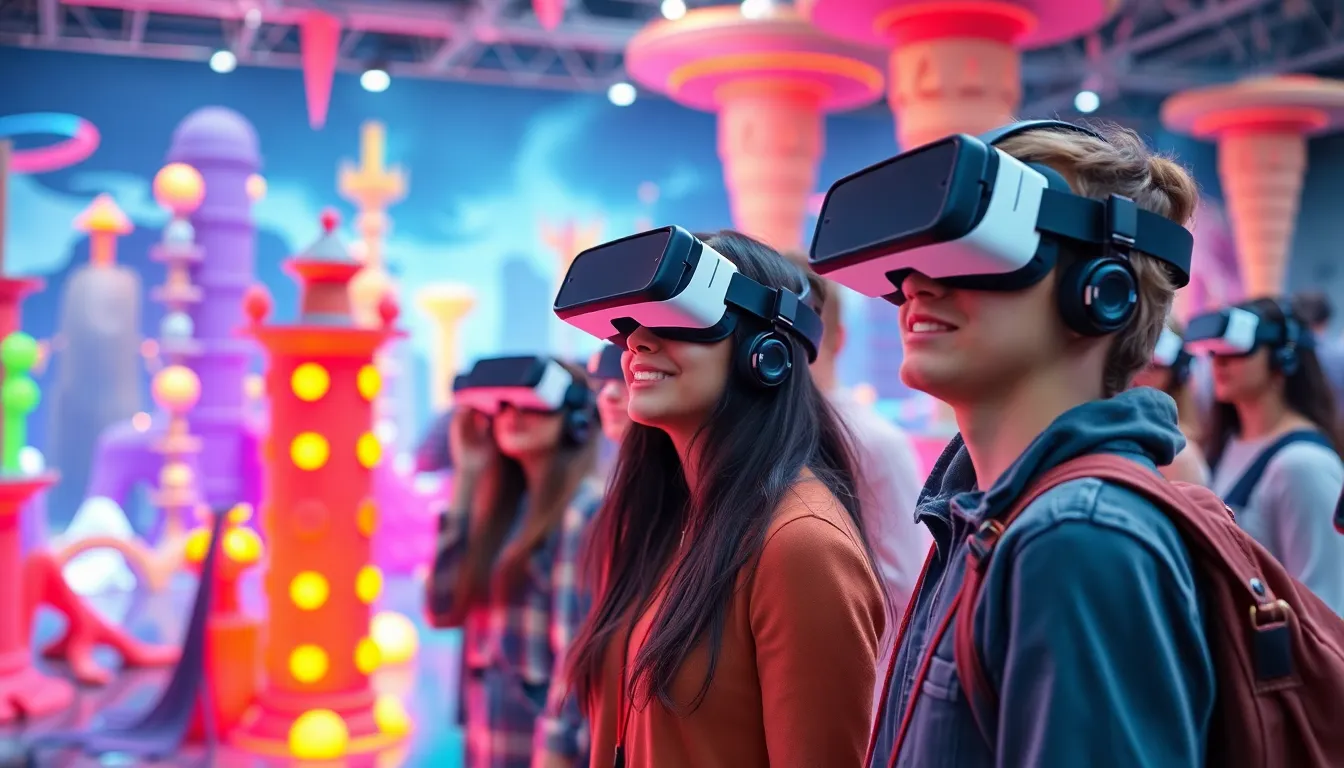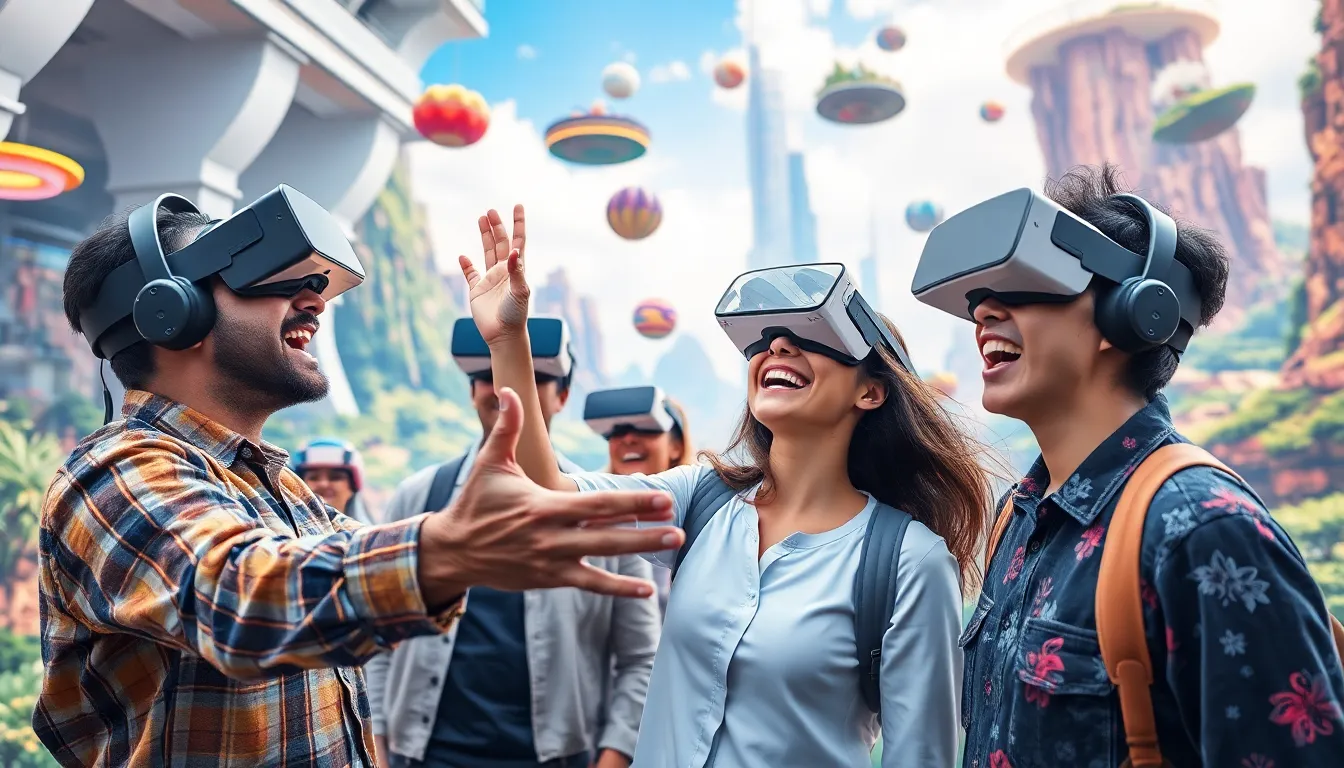As technology advances, virtual worlds are becoming more immersive and accessible, captivating the imagination of millions. These digital landscapes offer a chance to escape reality and explore realms limited only by creativity. From detailed simulations to fantastical environments, the possibilities are endless.
Exploring virtual worlds isn’t just about entertainment; it opens doors to new experiences, social interactions, and even educational opportunities. Gamers, educators, and professionals alike are discovering the benefits of stepping into these vibrant universes. As the lines between the physical and digital blur, understanding virtual worlds becomes essential for anyone eager to navigate this evolving landscape.
Table of Contents
ToggleUnderstanding Virtual Worlds Exploration
Virtual worlds encompass immersive digital environments where users interact with each other and the surroundings. Understanding these worlds is essential as they redefine experiences across various domains.
Definition and Concept
Virtual worlds are simulated environments created through computer technology, allowing users to explore, create, and communicate. Participants can engage in activities such as gaming, socializing, and educational pursuits. Examples include platforms like Second Life and VRChat, which provide distinct spaces for exploration and interaction. Users control avatars to navigate intricate landscapes, interact with other participants, and create personalized experiences.
Importance in Today’s Digital Age
In today’s digital age, virtual worlds play a critical role in shaping social interactions, learning methodologies, and entertainment experiences. They offer accessibility to educational resources and enable collaboration across geographical barriers. Virtual worlds facilitate networking opportunities for professionals, allowing for idea sharing and creativity. Statistical data indicates that over 50% of users report enhanced social connections through these platforms, highlighting their value in fostering community and engagement.
Types of Virtual Worlds

Virtual worlds come in various forms, each offering unique experiences and functionalities. Two prominent types include Massively Multiplayer Online Games (MMOs) and Virtual Reality Environments.
Massively Multiplayer Online Games (MMOs)
MMOs create expansive virtual worlds where thousands of players interact simultaneously. Players engage in activities like questing, trading, and combat, often in fantasy or sci-fi settings. Games like World of Warcraft and Final Fantasy XIV exemplify this genre, providing rich narratives and social interactions. Players build characters, form guilds, and embark on adventures, fostering dynamic experiences. A report from Newzoo indicates that the MMO market generated approximately $19.1 billion in 2022, reflecting its massive appeal.
Virtual Reality Environments
Virtual Reality Environments immerse users in three-dimensional worlds, enhancing the sense of presence. Technologies like head-mounted displays (HMDs) enable participants to explore virtual spaces interactively. Platforms such as Oculus Home and Rec Room exemplify these environments, offering socialization, gaming, and creative expressions. A study by Statista reports that the global virtual reality market is projected to reach $57.55 billion by 2027, driven by advancements in VR technology and increased consumer adoption.
Platforms for Virtual Worlds Exploration
Several platforms facilitate exploration of virtual worlds, offering unique experiences for users. These platforms cater to various interests, from gaming to educational pursuits.
Popular Gaming Platforms
- Second Life: Second Life allows users to create an avatar, design virtual spaces, and interact within a vast user-generated environment. The platform hosts millions of active users who engage in social activities, commerce, and creativity.
- VRChat: VRChat excels in social interaction, enabling users to connect through voice, text, and custom avatars. It features diverse worlds created by users, promoting creativity and community.
- World of Warcraft: As a leading MMO, World of Warcraft offers an expansive fantasy realm for players. Users participate in quests and raids, interact with other players, and experience rich storytelling.
- Fortnite: Fortnite integrates gaming and creative elements with its battle royale format. Players can build structures, customize characters, and explore various themed maps, enhancing engagement.
- Minecraft: Minecraft fosters exploration and creativity in a block-based world. Users build and craft their environments, which promotes teamwork and imagination among players.
Virtual Reality Headsets
- Oculus Quest 2: Oculus Quest 2 provides a standalone VR experience with a library of games and immersive environments. Its accessibility and affordable price point encourage widespread adoption.
- HTC Vive Pro 2: HTC Vive Pro 2 supports high-resolution visuals and motion tracking, offering an advanced VR experience. It’s suitable for both gaming and professional applications.
- Valve Index: Valve Index combines high-fidelity graphics with responsive tracking technology. It caters to serious gamers seeking an immersive and interactive experience.
- PlayStation VR: PlayStation VR integrates with PlayStation consoles, making VR gaming accessible to a broader audience. It features popular titles and engaging environments, appealing to console gamers.
- Pimax 8K X: Pimax 8K X boasts ultra-high resolution and a wide field of view, catering to enthusiasts who seek cutting-edge VR technology. Its versatility makes it suitable for gaming, simulation, and 3D applications.
Benefits of Virtual Worlds Exploration
Exploring virtual worlds offers significant benefits, especially in social interaction, networking, and educational opportunities. These aspects empower users to connect and learn in innovative ways.
Social Interaction and Networking
Engagement in virtual worlds fosters social connections and networking among diverse participants. Users can cultivate friendships with individuals from various geographical locations, promoting cultural exchanges. Over 50% of active users report enhanced social interactions through platforms like VRChat and Second Life. These virtual environments facilitate collaboration on projects and events, offering networking opportunities across industries. The immersive nature of these spaces allows for authentic communication, increasing the sense of community among participants.
Educational Opportunities
Virtual worlds present unique educational advantages, making learning more accessible and engaging. Educators leverage these environments to create interactive lessons that accommodate diverse learning styles. Students can collaborate on projects in real-time, breaking down geographical barriers. Universities and training programs use platforms to simulate real-world scenarios, enhancing practical skills in fields like medicine, engineering, and art. Reports indicate that virtual learning can improve information retention rates, making it a valuable tool in the academic landscape.
Challenges in Virtual Worlds Exploration
Navigating virtual worlds presents several challenges that affect user experience and exploration. Addressing those challenges can enhance the understanding of the digital landscape and improve engagement.
Psychological Effects
Psychological effects arise as individuals immerse themselves in virtual environments. Users may experience feelings of isolation or disconnection from the real world after prolonged exposure. Additionally, individuals might encounter cognitive overload due to the abundance of stimuli in these spaces. Studies indicate that 30% of users report increased anxiety when interacting extensively in virtual environments, emphasizing the need for balance. Other users may develop attachment to their avatars, which can lead to identity issues and impacts on self-esteem. Awareness of these psychological effects is crucial for balancing virtual exploration with real-world interactions.
Technical Limitations
Technical limitations often hinder the exploration of virtual worlds. Users may face connectivity issues, which disrupt the experience and limit accessibility. High-performance hardware requirements also prevent some users from engaging fully, with only 20% of users possessing advanced virtual reality equipment necessary for optimal experiences. Latency problems can make interactions feel laggy, diminishing the immersion crucial for retention. Furthermore, certain platforms may lack cross-compatibility, restricting user movement between different virtual environments. Recognizing these technical challenges can guide developers in creating more inclusive and accessible virtual spaces.
Virtual worlds are transforming how individuals interact learn and create. As technology continues to evolve these immersive environments will play an increasingly vital role in shaping social dynamics and educational experiences. The blend of entertainment and meaningful engagement found in these digital landscapes opens up new avenues for exploration and connection.
Understanding the potential of virtual worlds is essential for anyone looking to thrive in this rapidly changing digital landscape. Embracing these platforms not only enhances personal and professional growth but also fosters a sense of community that transcends geographical boundaries. As users navigate these virtual realms they’ll discover endless possibilities waiting to be explored.



